 Moon Girl and Devil Dinosaur #7 — Writers: Brandon Montclaire and Amy Reeder; Art: Marco Failla; Colors: Tamra Bonvillain
Moon Girl and Devil Dinosaur #7 — Writers: Brandon Montclaire and Amy Reeder; Art: Marco Failla; Colors: Tamra Bonvillain
The Unbeatable Squirrel Girl #8 — Writer: Ryan North; Art: Erica Henderson; Colors: Rico Renzi
Patsy Walker, A.K.A. Hellcat #6 — Writer: Kate Leth; Art/Colors: Natasha Allegri
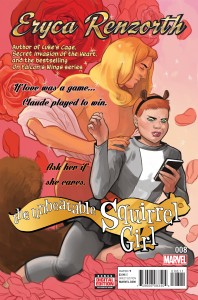 Ms. Marvel #7 — Writer: G. Willow Wilson; Art: Adrian Alphona; Colors: Ian Herring
Ms. Marvel #7 — Writer: G. Willow Wilson; Art: Adrian Alphona; Colors: Ian Herring
Mockingbird #3 — Writer: Chelsea Cain; Art: Kate Niemczyk
Captain Marvel #5 — Writers: Michele Fazekas and Tara Butters; Art: Kris Anka with Felipe Smith; Colors: 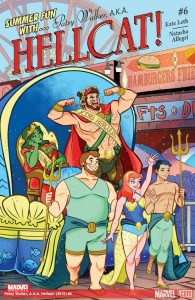 Matthew Wilson
Matthew Wilson
As so often in comics this year, the women rule: six books with female leads, all set in the regular Marvel universe. The first three are more new-reader friendly; Moon Girl and Devil Dinosaur is a perfect comic to read to younger kids, with its spunky, smart, determined heroine; its expressive art; its knack for making us care about, and root for, both of its title characters; and a last-scene twist that’s startling and fun (and clever — the next-issue splash has Lunella in a pose just like Max in Where the Wild Things Are). Squirrel Girl, like  Hellcat, has a more cartoony style; because it isn’t afraid to be silly sometimes, it’s easy to miss just how sophisticated it can be, and how smoothly North and Henderson work together. After sixteen issues, they’re confident enough to experiment with story structure and content, and every experiment pays off: witness last issue’s find-your-own-adventure format, and this issue’s plot about Doreen trying online dating (and contributing the phrase “super hero truther” to the Marvel lexicon); they make good comics storytelling look effortless. Hellcat has a very
Hellcat, has a more cartoony style; because it isn’t afraid to be silly sometimes, it’s easy to miss just how sophisticated it can be, and how smoothly North and Henderson work together. After sixteen issues, they’re confident enough to experiment with story structure and content, and every experiment pays off: witness last issue’s find-your-own-adventure format, and this issue’s plot about Doreen trying online dating (and contributing the phrase “super hero truther” to the Marvel lexicon); they make good comics storytelling look effortless. Hellcat has a very  cartoony style (guest artist Allegri is in Bryan Lee O’Malley territory), but an almost-traditional, if light-hearted, superhero plot about the gang (including She-Hulk) running into Arcade in Coney Island; it’s… well, “adorable” isn’t a word often associated with superhero comics, and it’s got a little more bite than that, but it really is hard to resist. Ms. Marvel is more firmly in the “real” Marvel universe (the plot involves Kamala and Miles “Spider-Man” Morales on different school teams in a prestigious high-school-science competition — and, while she knows who he is, he doesn’t know her civilian identity), but it shares the attention to warm, diverse
cartoony style (guest artist Allegri is in Bryan Lee O’Malley territory), but an almost-traditional, if light-hearted, superhero plot about the gang (including She-Hulk) running into Arcade in Coney Island; it’s… well, “adorable” isn’t a word often associated with superhero comics, and it’s got a little more bite than that, but it really is hard to resist. Ms. Marvel is more firmly in the “real” Marvel universe (the plot involves Kamala and Miles “Spider-Man” Morales on different school teams in a prestigious high-school-science competition — and, while she knows who he is, he doesn’t know her civilian identity), but it shares the attention to warm, diverse 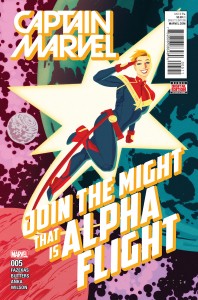 character development and theme of the others. Mockingbird, three issues in, offers an origin of sorts, mixing flashbacks to Bobbi Chase’s adolescence while she’s trying to defuse a modern-day crisis with a confused new mutant girl; it’s all meant to emphasize her smarts, athleticism and general bad-assery, and as a stand-alone tale it’s not a bad introduction to the series. Captain Marvel, meanwhile, concludes its first arc, about Carol and the Earth-defence space station Alpha Flight against an alien race who hate the Kree, assume that Carol’s one, and decide to take out both her and her (our) planet; its fast-paced action and mismatched-but-growing buddy-cop relationship between Carol and Agent Brand keep the energy and interest high, and keep it on this list.
character development and theme of the others. Mockingbird, three issues in, offers an origin of sorts, mixing flashbacks to Bobbi Chase’s adolescence while she’s trying to defuse a modern-day crisis with a confused new mutant girl; it’s all meant to emphasize her smarts, athleticism and general bad-assery, and as a stand-alone tale it’s not a bad introduction to the series. Captain Marvel, meanwhile, concludes its first arc, about Carol and the Earth-defence space station Alpha Flight against an alien race who hate the Kree, assume that Carol’s one, and decide to take out both her and her (our) planet; its fast-paced action and mismatched-but-growing buddy-cop relationship between Carol and Agent Brand keep the energy and interest high, and keep it on this list.
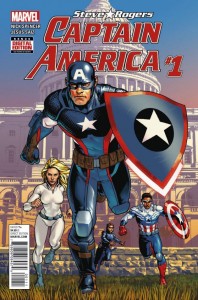 Captain America: Steve Rogers #1 — Writer: Nick Spencer; Art/Colors: Jesus Saiz
Captain America: Steve Rogers #1 — Writer: Nick Spencer; Art/Colors: Jesus Saiz
Nighthawk #1 — Writer: David F. Walker; Art: Ramon Villalobos; Colors: Tamra Bonvillain
Doctor Strange #8 — Writer: Jason Aaron; Pencils: Chris Bachalo; Inks: Five Guys; Colors: Three Guys
The Mighty Thor #7 — Writer: Jason Aaron; Art: Russell Dauterman, Rafa Garres; Colors: Matthew Wilson, Rafa Garres
Spiderman/Deadpool #5 — Writer: Joe Kelly; Pencils: Ed McGuinness; Innks: Mark Morales; Colors: Jason Keith
 Of the other Marvels for the week, Captain America‘s gotten the most attention, because of a last-page plot twist that seems to upend everything we’ve known about the character for 75 years; I won’t reveal it here (although it’s been extensively spoiled by the media), but it’s been generating predictable internet outrage from people who don’t understand comics, and think it will be permanent. Take it from a veteran reader: it’ll all turn out to be the result of time travel, cosmic cubes or both (the mysterious woman who sets things in motion in the past is likely to be whatsername, the Red Skull’s daughter), and after a year or two everything will revert back to its default setting. The real key is whether it leads to a good story, and since Spencer’s got a good track record and Saiz’s art is decent (nice composition, and he has some of Steve Dillon’s proficiency with
Of the other Marvels for the week, Captain America‘s gotten the most attention, because of a last-page plot twist that seems to upend everything we’ve known about the character for 75 years; I won’t reveal it here (although it’s been extensively spoiled by the media), but it’s been generating predictable internet outrage from people who don’t understand comics, and think it will be permanent. Take it from a veteran reader: it’ll all turn out to be the result of time travel, cosmic cubes or both (the mysterious woman who sets things in motion in the past is likely to be whatsername, the Red Skull’s daughter), and after a year or two everything will revert back to its default setting. The real key is whether it leads to a good story, and since Spencer’s got a good track record and Saiz’s art is decent (nice composition, and he has some of Steve Dillon’s proficiency with 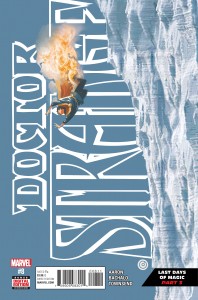 clear faces, but details them and roughs them up a little more), it’s best to just enjoy the ride. Nighthawk #1 benefits from no such publicity, and is OK: it’s the Squadron Supreme version of the character, a more-psychotic Batman (or, I suppose, a sort-of less-psychotic Rorschach), and he fights really psycho bad guys, the better to justify his extreme methods. Villalobos has a slightly-indy style that helps to keep things interesting, and if you liked the Daniel Way/Steve Dillon version of the character from a decade ago, this won’t disappoint you, although it breaks no new ground. Doctor Strange doesn’t have that problem — writer Jason Aaron thinks big, and the current storyline, involving the destruction of (almost) all magic on Earth by an inter-dimensional Inquisition, is giving the good doctor plenty of conflict and drama, and a chance to show what he can do besides just
clear faces, but details them and roughs them up a little more), it’s best to just enjoy the ride. Nighthawk #1 benefits from no such publicity, and is OK: it’s the Squadron Supreme version of the character, a more-psychotic Batman (or, I suppose, a sort-of less-psychotic Rorschach), and he fights really psycho bad guys, the better to justify his extreme methods. Villalobos has a slightly-indy style that helps to keep things interesting, and if you liked the Daniel Way/Steve Dillon version of the character from a decade ago, this won’t disappoint you, although it breaks no new ground. Doctor Strange doesn’t have that problem — writer Jason Aaron thinks big, and the current storyline, involving the destruction of (almost) all magic on Earth by an inter-dimensional Inquisition, is giving the good doctor plenty of conflict and drama, and a chance to show what he can do besides just 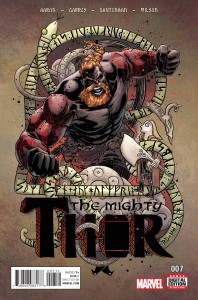 wiggle his fingers in the air; as always, the Chris Bachalo art (even with the tag-team inking, which is apparently the only way he can stick to a monthly schedule) is lush, well-designed and worth the book’s cost all by itself. Aaron’s also writing Mighty Thor, which concludes a change-of-pace two-parter that toggles between a present-day Loki scheming with Roxxon head Dario Agger, and a flashback to the original Thor during the Viking era (drawn by Rafa Garres, who brings an energetic, Simon Bisely-ish style to all that barbarian violence); if you’re a fan of the Jane Foster version of the character, you’ll have to wait until next issue, but, considering that Aaron’s made this book just as far-out and frenetic in pace as Doctor Strange, it’ll be worth it.
wiggle his fingers in the air; as always, the Chris Bachalo art (even with the tag-team inking, which is apparently the only way he can stick to a monthly schedule) is lush, well-designed and worth the book’s cost all by itself. Aaron’s also writing Mighty Thor, which concludes a change-of-pace two-parter that toggles between a present-day Loki scheming with Roxxon head Dario Agger, and a flashback to the original Thor during the Viking era (drawn by Rafa Garres, who brings an energetic, Simon Bisely-ish style to all that barbarian violence); if you’re a fan of the Jane Foster version of the character, you’ll have to wait until next issue, but, considering that Aaron’s made this book just as far-out and frenetic in pace as Doctor Strange, it’ll be worth it.  Finally, Spider-Man/Deadpool picks up from the last panel of last issue, where Wade killed Peter Parker (long story), and involves Peter actually being dead, and Wade journeying to hell to get him back (Wade being long-time friends with Death and all); this sounds like it couldn’t possibly work, but Kelly and McGuiness, who were the creative team at the beginning of the original Deadpool run back in the ’90s, know exactly how to handle both title characters, and make it both fun and surprisingly affecting — there’s a reason that this comic has become a hit, with five printings of the first issue, and even if you thought the world might not have needed another Deadpool book right now, it’s the best of the bunch.
Finally, Spider-Man/Deadpool picks up from the last panel of last issue, where Wade killed Peter Parker (long story), and involves Peter actually being dead, and Wade journeying to hell to get him back (Wade being long-time friends with Death and all); this sounds like it couldn’t possibly work, but Kelly and McGuiness, who were the creative team at the beginning of the original Deadpool run back in the ’90s, know exactly how to handle both title characters, and make it both fun and surprisingly affecting — there’s a reason that this comic has become a hit, with five printings of the first issue, and even if you thought the world might not have needed another Deadpool book right now, it’s the best of the bunch.
 Justice League #50 — Writer: Geoff Johns; Art: Jason Fabok; Colors: Brad Anderson
Justice League #50 — Writer: Geoff Johns; Art: Jason Fabok; Colors: Brad Anderson
Superman #52 — Writer: Peter J. Tomasi; Art: Mikel; Janin with Miguel Sepulveda; Colors: Janin and Jeromy Cox
DC Universe: Rebirth #1 (of 1) — Writer: Geoff Johns; Art: Ethan van Sciver, Gary Frank, Ivan Reis, Phil Jimenez and Gary Frank, Gary Frank and Ivan Reis
 Scooby Apocalypse #1 — Plot and Breakdowns: Keith Giffen; Dialogue: J.M. DeMatteis; Art: Howard Porter; Colors: Hi-Fi
Scooby Apocalypse #1 — Plot and Breakdowns: Keith Giffen; Dialogue: J.M. DeMatteis; Art: Howard Porter; Colors: Hi-Fi
Secret Six #14 — Writer: Gail Simone; Art: Tom Derenick; Colors: Jason Wright and Rex Lokus
Batgirl #52 — Writer: Brenden Fletcher; Art: Eleonora Carlini and Minkyu Jung; Colors: Serge LaPointe
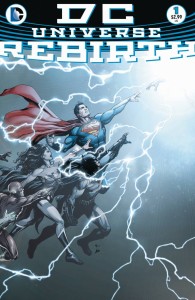 Quite a bit’s going on with DC this week — beginnings and endings, especially. They combine in Rebirth #1 — but, before you read it, pick up Justice League #50 and Superman #52; the former ends the long-running “Darkseid War” serial, and sets up a couple of Rebirth beats (since both are written by Geoff Johns), while the latter finishes the “Last Days of Superman” arc with, yes, the death of the new-52 Man of Steel (this leaves the pre-new-52, bearded, married-to-Lois-with-a-son Clark Kent, whom I think we can all agree will now be known as “Old Man Superman”…). Rebirth offers a 64-page story for $2.99 (with no outside ads,
Quite a bit’s going on with DC this week — beginnings and endings, especially. They combine in Rebirth #1 — but, before you read it, pick up Justice League #50 and Superman #52; the former ends the long-running “Darkseid War” serial, and sets up a couple of Rebirth beats (since both are written by Geoff Johns), while the latter finishes the “Last Days of Superman” arc with, yes, the death of the new-52 Man of Steel (this leaves the pre-new-52, bearded, married-to-Lois-with-a-son Clark Kent, whom I think we can all agree will now be known as “Old Man Superman”…). Rebirth offers a 64-page story for $2.99 (with no outside ads, 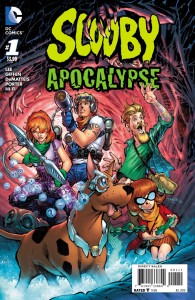 although at the end there’s fourteen pages of promos for all the new titles coming), a canny move by DC; so is having Johns, who’s been very good at these game-altering special events for a long time, be the writer, with an all-star lineup of artists to handle the story’s five parts. It starts with the pre-new-52 Wally West showing up, trying to warn the heroes that they’ve been living in an altered universe, and ends with a typically-audacious Johns plot twist that’s both unexpected and makes perfect sense; if a company-wide relaunch like this is going to work, it needs to offer something exciting to fans, and this is an
although at the end there’s fourteen pages of promos for all the new titles coming), a canny move by DC; so is having Johns, who’s been very good at these game-altering special events for a long time, be the writer, with an all-star lineup of artists to handle the story’s five parts. It starts with the pre-new-52 Wally West showing up, trying to warn the heroes that they’ve been living in an altered universe, and ends with a typically-audacious Johns plot twist that’s both unexpected and makes perfect sense; if a company-wide relaunch like this is going to work, it needs to offer something exciting to fans, and this is an 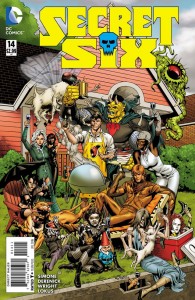 encouraging start. Speaking of complete reboots, there’s Scooby Apocalypse, which started with a Jim Lee reimagining of the Mystery Machine gang and their off-kilter canine for the ’10s, and now kicks off with an origin story by Giffen and DeMatteis, who’ve been collaborating since back in the ’80s JLA bwah-ha-ha days. Given the outrage expressed over the Lee cover a few months back (it shows Shaggy as a hipster, Velma as a little person, Fred with tattoos, and so on), it’s actually a decent story (albeit a lot heavier on the science than the supernatural), with a first meeting of Shaggy and Scooby that’s almost heartwarming, and more than enough to bring readers back for at least another issue or two. That
encouraging start. Speaking of complete reboots, there’s Scooby Apocalypse, which started with a Jim Lee reimagining of the Mystery Machine gang and their off-kilter canine for the ’10s, and now kicks off with an origin story by Giffen and DeMatteis, who’ve been collaborating since back in the ’80s JLA bwah-ha-ha days. Given the outrage expressed over the Lee cover a few months back (it shows Shaggy as a hipster, Velma as a little person, Fred with tattoos, and so on), it’s actually a decent story (albeit a lot heavier on the science than the supernatural), with a first meeting of Shaggy and Scooby that’s almost heartwarming, and more than enough to bring readers back for at least another issue or two. That  leaves the two final issues, of Secret Six and Batgirl; they’re much different in tone (Secret Six, by nature a horror comic, has always delighted in pushing the envelope of the bizarre, while Batgirl’s gotten by with a much sunnier optimism), but both, at base, have been about family and loyalty, and both end with those values satisfyingly in place. Barbara Gordon’s coming back in the relaunch, in a team-up book with Huntress and Black Canary called Batgirl and the Birds of Prey; Secret Six hasn’t been scheduled, but it’s a title that’s been through numerous cancellations before, and always arisen from the dead, so here’s hoping that we’ll see it and its quirky little view of the DC universe again.
leaves the two final issues, of Secret Six and Batgirl; they’re much different in tone (Secret Six, by nature a horror comic, has always delighted in pushing the envelope of the bizarre, while Batgirl’s gotten by with a much sunnier optimism), but both, at base, have been about family and loyalty, and both end with those values satisfyingly in place. Barbara Gordon’s coming back in the relaunch, in a team-up book with Huntress and Black Canary called Batgirl and the Birds of Prey; Secret Six hasn’t been scheduled, but it’s a title that’s been through numerous cancellations before, and always arisen from the dead, so here’s hoping that we’ll see it and its quirky little view of the DC universe again.
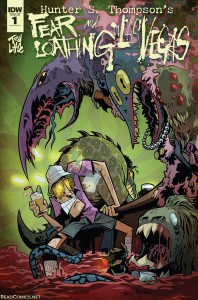 Fear and Loathing in Las Vegas #1 — Adaptation: Troy Little; Design: Troy Little, Chris Ross and Robbie Robbins
Fear and Loathing in Las Vegas #1 — Adaptation: Troy Little; Design: Troy Little, Chris Ross and Robbie Robbins
Afterlife With Archie #9 — Writer: Roberto Aguirre-Sacasa; Art/Colors: Francesco Francavilla
Monstress #6 — Writer: Marjorie Liu; Art/Colors: Sana Takeda
Rick and Morty #14 — Writer: Tom Fowler; Art: CJ Cannon; Colors: Ryan Hill
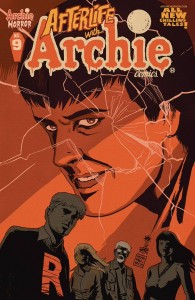 Jem and the Holograms #15 — Writer: Kelly Thompson; Art: Sophie Campbell; Colors: M. Victoria Robado
Jem and the Holograms #15 — Writer: Kelly Thompson; Art: Sophie Campbell; Colors: M. Victoria Robado
Rachel Rising #42 (of 42) — Creator: Terry Moore
Lots of interesting indy books this week. Fear and Loathing in Las Vegas is, of course, an adaptation of that early-’70s experiment in drug-addled gonzo journalism — and a very faithful one, with the comic’s 40 pages of story covering just the first four chapters, about 24 pages, of my yellowing paperback copy of the original book, and 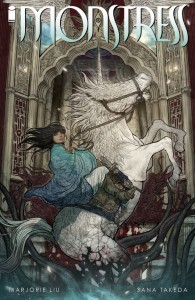 preserving Thompson’s chapter headings and much of his language. The art, wisely, doesn’t attempt to copy Ralph Steadman’s original ink-splattered illustrations, opting instead for a clear, cartoony style with solid black lines and lots of flexibility for the hallucinations and various goings-on; it might be faint praise to say a comic’s much better than you thought it was going to be, but that’s the case here, and more power to it. Afterlife With Archie returns after a long hiatus (following Sabrina, which published a new issue just last week), and puts its EC-inspired spotlight on Reggie Mantle; it makes good use of the no-one’s-a-villain-in-his-
preserving Thompson’s chapter headings and much of his language. The art, wisely, doesn’t attempt to copy Ralph Steadman’s original ink-splattered illustrations, opting instead for a clear, cartoony style with solid black lines and lots of flexibility for the hallucinations and various goings-on; it might be faint praise to say a comic’s much better than you thought it was going to be, but that’s the case here, and more power to it. Afterlife With Archie returns after a long hiatus (following Sabrina, which published a new issue just last week), and puts its EC-inspired spotlight on Reggie Mantle; it makes good use of the no-one’s-a-villain-in-his-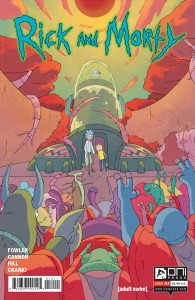 own-mind trope, and even gets us to sympathize with the little jerk… until the end, where he agrees to do something horrible, this not being a book that’s big on redemption or happy endings; as always, it’s a creepy, satisfyingly-weird take on the Riverdale gang, with Francavilla’s art enhancing it with just the right combination of caricature and horror. Monstress continues its high-fantasy tale about a halfbreed magical girl with a Lovecraftian monster inside of her; Liu’s gotten very good at adding the story beats in just the right places, and keeping readers surprised, while Tanaka’s art blends American and Japanese influences just as gracefully as it combines the quiet moments and
own-mind trope, and even gets us to sympathize with the little jerk… until the end, where he agrees to do something horrible, this not being a book that’s big on redemption or happy endings; as always, it’s a creepy, satisfyingly-weird take on the Riverdale gang, with Francavilla’s art enhancing it with just the right combination of caricature and horror. Monstress continues its high-fantasy tale about a halfbreed magical girl with a Lovecraftian monster inside of her; Liu’s gotten very good at adding the story beats in just the right places, and keeping readers surprised, while Tanaka’s art blends American and Japanese influences just as gracefully as it combines the quiet moments and 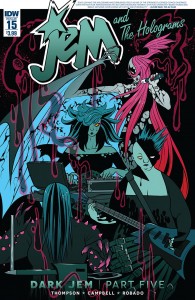 the horrific ones. Meanwhile, I’ve become a big fan of Rick and Morty, even though I’ve never seen the cartoon — I like its cynicism occasionally leavened with sentimentality, its willingness to push the parallel-worlds conceit further than anyone else (and use that as a get-out-of-jail-free card, even when seemingly horrible things happen to its main characters), and its snarky self-awareness. All of those things are on display in this issue (it’s the conclusion to a three-part story, but you don’t really need to know anything about the plot to enjoy it; it isn’t that kind of book), and it’s a good sampler to see if you’d like it too. Jem and the Holograms continues a long multi-parter about Synergy, the electrical being that controls the holograms/illusions
the horrific ones. Meanwhile, I’ve become a big fan of Rick and Morty, even though I’ve never seen the cartoon — I like its cynicism occasionally leavened with sentimentality, its willingness to push the parallel-worlds conceit further than anyone else (and use that as a get-out-of-jail-free card, even when seemingly horrible things happen to its main characters), and its snarky self-awareness. All of those things are on display in this issue (it’s the conclusion to a three-part story, but you don’t really need to know anything about the plot to enjoy it; it isn’t that kind of book), and it’s a good sampler to see if you’d like it too. Jem and the Holograms continues a long multi-parter about Synergy, the electrical being that controls the holograms/illusions 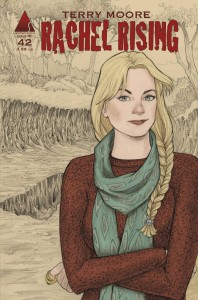 that power the group, being co-opted by something considerably darker; Thompson’s got an aptitude for making you care about her characters and their complicated interrelationships (and an ear for dialogue: one of the girls calls another a “douche canoe”), and Campbell toggles between cute and spiky, her graceful minimalist designs enhanced by Robado’s bold colors and backgrounds. That leaves Rachel Rising, whose final-issue coda to last issue’s climax sees Rachel getting revenge and closure for her murder. If you’ve never read this before, don’t read this last issue now; go get the trade collections instead. For longtime fans: don’t miss the after-the-credits blackout scene.
that power the group, being co-opted by something considerably darker; Thompson’s got an aptitude for making you care about her characters and their complicated interrelationships (and an ear for dialogue: one of the girls calls another a “douche canoe”), and Campbell toggles between cute and spiky, her graceful minimalist designs enhanced by Robado’s bold colors and backgrounds. That leaves Rachel Rising, whose final-issue coda to last issue’s climax sees Rachel getting revenge and closure for her murder. If you’ve never read this before, don’t read this last issue now; go get the trade collections instead. For longtime fans: don’t miss the after-the-credits blackout scene.



